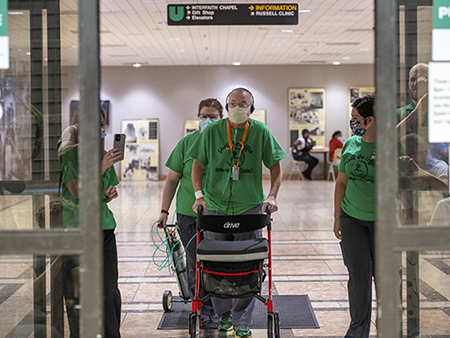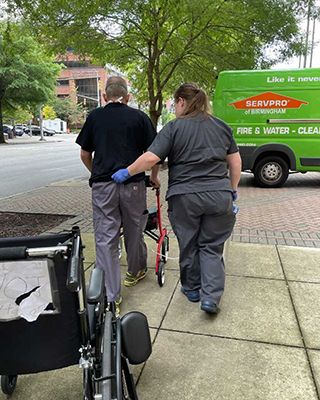 Hamm was on ECMO for 147 days, a remarkably long time.
Hamm was on ECMO for 147 days, a remarkably long time.
(Photography: Steve Wood)Ricky Hamm is no stranger to UAB Hospital. A medevac helicopter pilot, he has been flying ill and injured patients to UAB for 17 years. He was the first medevac pilot to touch down on the landing pad of UAB’s new North Pavilion when it opened in 2004. On Jan. 10, 2021, he found himself at the North Pavilion again, but this time as a patient.
A COVID-19 patient. It would be 187 days before he would go home.
Hamm is not sure how he contracted the virus. Five co-workers also were COVID-positive at the same time in January, so he may have picked it up at work.
“We live in a rural area, and I always wore a mask and kept my distance when going to town,” Hamm said. “A bunch of us went to get the first dose of the Moderna vaccine, but I must have already had the virus.”
Hamm, a veteran who first flew medevac in the army, began to feel sick Jan. 5. Five days later, he was in UAB Hospital with severe breathing issues. He was not a good candidate for a ventilator, an artificial breathing machine often used with COVID-19 patients. His physicians had to turn to ECMO.
ECMO, or extracorporeal membrane oxygenation, is a device that removes a patient’s blood, filters out the carbon dioxide and adds oxygen. The blood is then pumped back into the body. In effect, the machine takes over the roles of both heart and lungs.
“ECMO is a complicated, complex procedure,” said Keith Wille, M.D., professor in UAB’s Division of Pulmonary and Critical Care Medicine and medical director of the adult ECMO program. “It’s invasive and not much fun for the patient. In this case, it saved his life. But trust me; you do not want to go on ECMO.”
 UAB is one of the few medical centers where ECMO patients are awake and conscious. That allows for physical, occupational, speech and music therapy while patients are on ECMO. Early mobility is extremely important for these critically ill patients.Hamm was on ECMO for 147 days, a remarkably long time. He also has the dubious distinction of being UAB’s longest-tenured COVID-19 patient, at 187 days. He will still be on supplemental oxygen after discharge, and he will use an extra-strength CPAP machine at night for a while to help his breathing. He has suffered profound hearing loss, which his wife, Shannon, a speech pathologist, hopes may resolve over time. His bout with COVID-19 was severe.
UAB is one of the few medical centers where ECMO patients are awake and conscious. That allows for physical, occupational, speech and music therapy while patients are on ECMO. Early mobility is extremely important for these critically ill patients.Hamm was on ECMO for 147 days, a remarkably long time. He also has the dubious distinction of being UAB’s longest-tenured COVID-19 patient, at 187 days. He will still be on supplemental oxygen after discharge, and he will use an extra-strength CPAP machine at night for a while to help his breathing. He has suffered profound hearing loss, which his wife, Shannon, a speech pathologist, hopes may resolve over time. His bout with COVID-19 was severe.
“He had a lot of support from family and friends,” said Shannon Hamm. “We were not sure how it was going to go at first. He was basically out of it for about four months. Once he woke up and joined the fight, things got a lot better. Then we knew he was going to make it.”
On July 16, Hamm’s family, friends in the EMS community and his co-workers celebrated his discharge from UAB, complete with a blue-light escort from Jefferson County and other area sheriff’s departments.
Hamm, speaking to members of the media outside the hospital, offered his support for vaccination.
“I believe in the vaccine,” he said. “I believe I already had the virus before I got the vaccine, before it could work to protect me. I wouldn’t want anyone to go through what I went through.”
Hamm’s wife, Shannon, says they were halfway through construction of a new house when Hamm got sick. The contractors have now finished, and Hamm got his first look at the house as the caravan bringing him home from the hospital pulled up.
“We built it to live in the rest of our lives,” he said. “Built ramps and wide doorways. No stairs. It was for when we grew old. I never expected to need handicap access quite this soon.”
For video footage of Hamm's hospital departure, click here.
Hamm is 50 years old. They did not celebrate his birthday much in 2020 due to the pandemic. They will celebrate this time. He came home from the hospital — after more than seven months — the day before his 51st birthday.